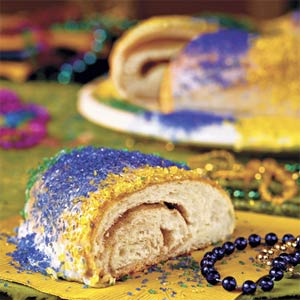Welcome to Mardi Gras week at Embellished Bayou! Let’s get the party started!
Being a Louisiana native, naturally Mardi Gras is one of my favorite holidays. In fact, since Fat Tuesday is on February 16 this year, I have totally skipped decorating for Valentine’s Day and put out all my Mardi Gras decor instead.
I have celebrated Mardi Gras since I was a baby, attending everything from small town parades to super-krewe parades in New Orleans. So I thought I would share a little history and fun facts for those of you who are not too familiar with what Mardi Gras is all about.
You can Google to get a complete history of Mardi Gras, but here are some of the highlights as it relates to Louisiana:
- When is Mardi Gras? The Mardi Gras season begins on or after the Epiphany (or Twelfth Night) and ends on the day before Ash Wednesday (Mardi Gras=French for Fat Tuesday) source
- Why do we celebrate Mardi Gras? Mardi Gras is a period of abandon and merriment that precedes the penance of Lent. Although originally of pagan content, the traditional carnival celebrations which precede Lent in many cultures have become associated with the season of fasting if only because they are a last opportunity for excess before Lent begins. source
- When was the first Mardi Gras parade in Louisiana?
The Mistick Krewe of Comus made its parading debut in a torch-lit procession on the night of Mardi Gras with two floats, costumed maskers and brass bands in 1857. A group of businessmen and civic leaders invented a king of Carnival, Rex, in 1872. source

- What’s the deal with the beads and coins? The throwing of trinkets to the crowds was started in the early 1870s by the Twelfth Night Revelers. In 1884, Rex started using medallions instead of trinkets. These medallions are represented by today's doubloons. Doubloons are usually aluminum and anodized in many different colors. They depict the parade theme on one side and the Krewe's emblem on the other. source Other throws may include stuffed animals, small toy/trinkets, and even food like Moon Pies and hot dogs! Try yelling “Throw me something, Mister!” at the float riders and see what you can catch! As a float is passing, instead of just waiving and glancing quickly from rider to rider, zero in on a single rider. Establish eye contact, flash a big smile and make a lot of noise. Watch out while trying to pick up throws from the ground, you may get your fingers smashed as it is customary to step on a bead/doubloon on the ground, then bend down and pick it up.

- Why all the purple, green and gold? Rex selected the official Mardi Gras colors in 1872. The 1892 Rex Parade theme Symbolism of Colors gave meaning to the colors: Purple represents justice; green, faith; and gold, power. source

- Who’s in charge of the parades, and how do I attend one? Krewes, or bands of people, construct their own floats and/or organize themselves to parade during Mardi Gras. The first krewe, formed in 1857, was called the Mystick Krewe of Comus, and the second krewe – the Krewe of Rex – was not established until 1872. source Most Krewes developed from private social clubs that have restrictive membership policies. Today, in order to obtain a Parade Permit, all Orleans Parish Clubs must sign Affidavits agreeing not to discrimate in terms of membership, but many of the more established Krewes continue to allow membership by "invitation only." source Krewe members are assessed fees in order to pay for the parade and/or ball. Fees can range from thousands of dollars a year per person for the most elaborate parades to as little as $20 a year for smaller marching clubs. source Check the parade schedule for your town to find out when and where the parades are held. Best of all, they’re FREE!!

- What is a King Cake? The king cake of the New Orleans Mardi Gras tradition comes in a number of styles. The most simple, said to be the most traditional, is a ring of twisted bread similar to that used in brioche topped with icing or sugar, usually colored purple, green, and gold. Some varieties have filling inside, the most common being cream cheese followed by praline. Popular bakeries such as Gambino's, Haydel’s, and Randazzo’s, feature original recipes and types of king cakes. The cakes have a small plastic baby (sometimes said to represent Baby Jesus) inside, and the person who gets the piece of cake with the baby has various privileges and obligations (such as buying the cake for next year's celebration). source
Mardi Gras Fun Facts
- The average rider in a parade spends $600 to $800 just on throws, with some high rollers spending $2,500 or more. For a mega-parade like Endymion, with over 2,000 riders, that means upwards of $1.5 million of goodies tossed in a matter of hours.
- Float parades were banned from the French Quarter’s narrow streets in 1973.
- More than 500,000 king cakes are sold each year in New Orleans between January 6 and Fat Tuesday, and another 50,000 are shipped out-of-state via overnight courier.
-
The super parades of Endymion and Bacchus, scheduled for the Saturday and Sunday before Fat Tuesday, feature a combined total of 75 floats, 60 marching bands and more than 250 units. Their 2,300 members toss more than 1.5 million cups, 2.5 million doubloons and 200,000 gross of beads.
-
One of the most photographed objects in all of Mardi Gras is the Boeuf Gras float in the Rex parade. Since the Middle Ages, the bouef gras (fatted bull) has been the symbol of the last meat eaten before Lent. While once a live bull was included in the procession, now a huge papier-mache' figure appears.
source source
Congratulations if you made it through this long post!! Join me tomorrow to share your favorite Mardi Gras photos and memories.

















































thanks! great info!
ReplyDeleteVery interesting - I'm glad to learn more about Mardi Gras! Can't wait for the rest of this weeks posts!
ReplyDeleteWow, tons of info! I've never been to Mardi Gras, but I come down every year for St. Paddy's.
ReplyDeleteYaY, Mardi Gras is my absolute favorite holiday!!!!
ReplyDeleteI learned so many new things. I just wish that I could experience it for myself. I will just have to live vicariously through your posts.
ReplyDeleteGreat facts! In all the years since I started college and became friends with people from New Orleans I still haven't been to Mardi Gras
ReplyDeleteNeat! I plan on going one day! Thanks for all the information!
ReplyDeleteKim
I did the same thing a couple of years ago--telling folks about Mardi Gras. Its nice to see that others are as passionate about Mardi Gras that they want to share it with those that haven't been.
ReplyDeleteAnd for those that haven't been--it's high time they got down to the LA, MS, or AL coast and party hardy!!!!
Very cool! Now I want to hop on a plane! I'd love to see it one day, it's on the list. Thanks to blogging, I'll get a little peek! :-)
ReplyDelete